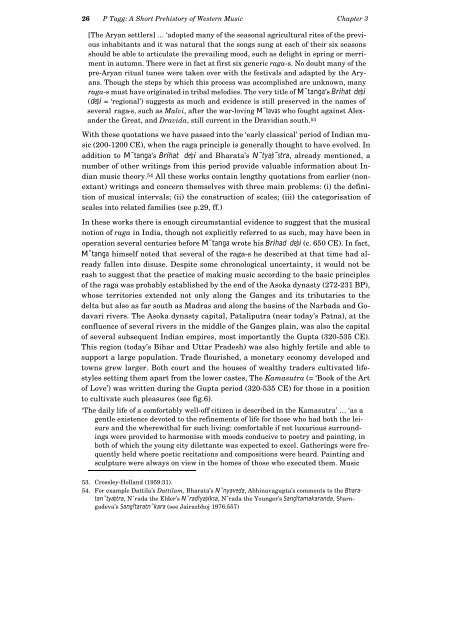A Short Prehistory of Western Music, Chapter 3
A Short Prehistory of Western Music, Chapter 3
A Short Prehistory of Western Music, Chapter 3
You also want an ePaper? Increase the reach of your titles
YUMPU automatically turns print PDFs into web optimized ePapers that Google loves.
26 P Tagg: A <strong>Short</strong> <strong>Prehistory</strong> <strong>of</strong> <strong>Western</strong> <strong>Music</strong> <strong>Chapter</strong> 3<br />
[The Aryan settlers] … ‘adopted many <strong>of</strong> the seasonal agricultural rites <strong>of</strong> the previous<br />
inhabitants and it was natural that the songs sung at each <strong>of</strong> their six seasons<br />
should be able to articulate the prevailing mood, such as delight in spring or merriment<br />
in autumn. There were in fact at first six generic raga-s. No doubt many <strong>of</strong> the<br />
pre-Aryan ritual tunes were taken over with the festivals and adapted by the Aryans.<br />
Though the steps by which this process was accomplished are unknown, many<br />
raga-s must have originated in tribal melodies. The very title <strong>of</strong> M˜tanga’s Brihat deþi<br />
(deþi = ‘regional’) suggests as much and evidence is still preserved in the names <strong>of</strong><br />
several raga-s, such as Malvi, after the war-loving M˜lavas who fought against Alexander<br />
the Great, and Dravida, still current in the Dravidian south. 53<br />
With these quotations we have passed into the ‘early classical’ period <strong>of</strong> Indian music<br />
(200-1200 CE), when the raga principle is generally thought to have evolved. In<br />
addition to M˜tanga’s Brihat deþi and Bharata’s N˜tyaþ˜stra, already mentioned, a<br />
number <strong>of</strong> other writings from this period provide valuable information about Indian<br />
music theory. 54 All these works contain lengthy quotations from earlier (nonextant)<br />
writings and concern themselves with three main problems: (i) the definition<br />
<strong>of</strong> musical intervals; (ii) the construction <strong>of</strong> scales; (iii) the categorisation <strong>of</strong><br />
scales into related families (see p.29, ff.)<br />
In these works there is enough circumstantial evidence to suggest that the musical<br />
notion <strong>of</strong> raga in India, though not explicitly referred to as such, may have been in<br />
operation several centuries before M˜tanga wrote his Brihad deþi (c. 650 CE). In fact,<br />
M˜tanga himself noted that several <strong>of</strong> the raga-s he described at that time had already<br />
fallen into disuse. Despite some chronological uncertainty, it would not be<br />
rash to suggest that the practice <strong>of</strong> making music according to the basic principles<br />
<strong>of</strong> the raga was probably established by the end <strong>of</strong> the Asoka dynasty (272-231 BP),<br />
whose territories extended not only along the Ganges and its tributaries to the<br />
delta but also as far south as Madras and along the basins <strong>of</strong> the Narbada and Godavari<br />
rivers. The Asoka dynasty capital, Pataliputra (near today’s Patna), at the<br />
confluence <strong>of</strong> several rivers in the middle <strong>of</strong> the Ganges plain, was also the capital<br />
<strong>of</strong> several subsequent Indian empires, most importantly the Gupta (320-535 CE).<br />
This region (today’s Bihar and Uttar Pradesh) was also highly fertile and able to<br />
support a large population. Trade flourished, a monetary economy developed and<br />
towns grew larger. Both court and the houses <strong>of</strong> wealthy traders cultivated lifestyles<br />
setting them apart from the lower castes, The Kamasutra (= ‘Book <strong>of</strong> the Art<br />
<strong>of</strong> Love’) was written during the Gupta period (320-535 CE) for those in a position<br />
to cultivate such pleasures (see fig.6).<br />
‘The daily life <strong>of</strong> a comfortably well-<strong>of</strong>f citizen is described in the Kamasutra’ … ‘as a<br />
gentle existence devoted to the refinements <strong>of</strong> life for those who had both the leisure<br />
and the wherewithal for such living: comfortable if not luxurious surroundings<br />
were provided to harmonise with moods conducive to poetry and painting, in<br />
both <strong>of</strong> which the young city dilettante was expected to excel. Gatherings were frequently<br />
held where poetic recitations and compositions were heard. Painting and<br />
sculpture were always on view in the homes <strong>of</strong> those who executed them. <strong>Music</strong><br />
53. Crossley-Holland (1959:31).<br />
54. For example Dattila’s Dattilam, Bharata’s N˜nyaveda, Abhinavagupta’s comments to the Bharatan˜tyaþtra,<br />
N˜rada the Elder’s N˜radŸyaþiksa, N˜rada the Younger’s SangŸtamakaranda, Sharngadeva’s<br />
SangŸtaratn˜kara (see Jairazbhoj 1976:557)














